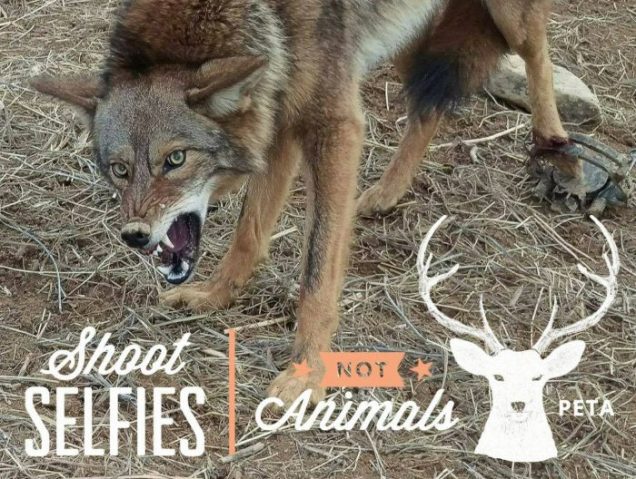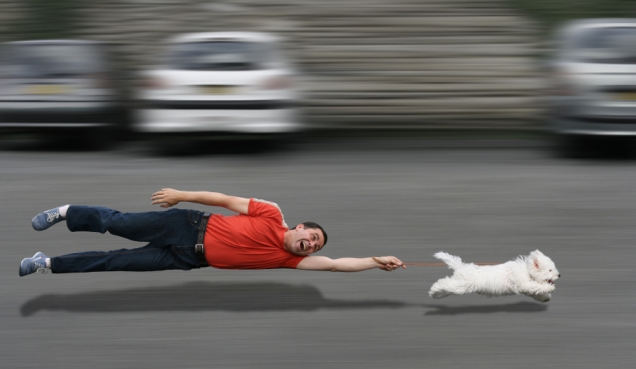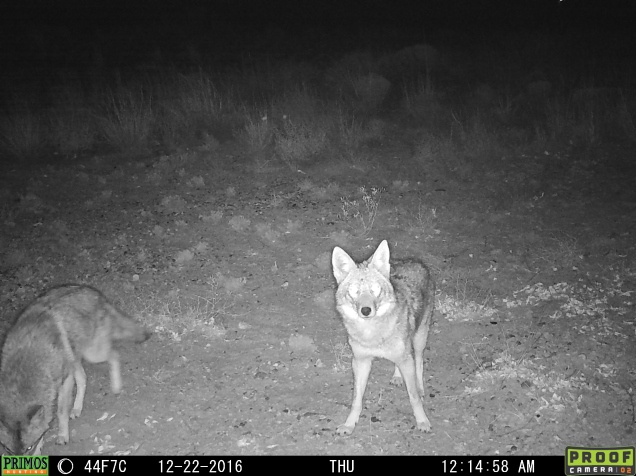Nature pits the Coyote against humans and the Coyote are winning. However, a story coming out of San Francisco California suggests a different perspective on that relationship. This is an interesting comment about the Coyote’s ability to thrive in an urban environment based on the local newspaper’s other entertainment value. Coyotes have learned over the years that survival depends on its ability to blend into its surroundings. In the above story the newspaper carrier simply wants to end having to re-deliver papers. His solution only serves to reinforce to a Coyote, humans are not to be feared! As this blog has pointed out lo these many month, Coyotes do very well in municipal settings Thank You very much! But why do Coyotes do as well as they do when everyone hates them? The secret is that not every one hates the Coyote (nuisance animals in general). The National Park Service reports on a regular basis that even with signs reading, DO NOT FEED THE WILDLIFE – their Rangers still find piles of pet food left along trails. People have been cited for illegally feeding wild animals yet the practice continues. Now, we have a paper carrier encouraging a Coyote to retrieve and play with substitute newspapers. These misguided but well meaning folks do not understand that feeding / playing with the wildlife diminishes the fear of humans. Not only will the wildlife lose their fear of humans they will forgo their natural hunting instincts to dine at the local neighborhood garbage can or backyard pet food bowl.
There are a lot of stories these days about Coyotes stalking family pets and carrying those pets off while the owner’s watch in horror.
Yes, some pets do survive the initial attack only to suffer until death takes their pain away. Pets that do live through their injuries are fortunate though often traumatized to the point of not being able to do their business without looking over their shoulders! Here is the point that falls through many of the “attack stories,” wild life offers other ways to kill then just aggressive attacks.
K9 Parvo, Distemper and Rabies are all carried by wild life not just Coyotes.
(https://www.akc.org/expert-advice/health/common-conditions/parvo-in-dogs/),
However, this blog’s focus is on Coyotes living among us so it is important to understand that these days one is just as likely to encounter a Coyote as any other wild life. Remember it isn’t just the physical presence of a Coyote transferring diseases during an assault it is also shedding and their fecal matter we must be concerned with. All animals primarily experience their world through sounds, smell and taste. As we walk through the neighborhood we pick up all sorts of unseen debris on our shoes and clothes. Just our walk through the neighborhood can infect our pets. The pets use their sense of smell and taste to see their world during those walks. Who hasn’t walked into their homes only to have the family pet come wagging their tails and beg for a pet on their head? We bring all kinds of infectious diseases into our homes without ever realizing it. Keeping the pet food bowls picked up and the garbage can lids secure are only the first lines of defense against Coyotes. It is important to know what has passed this way and what we step in!
So what do we do to avoid Coyotes in our neighborhoods? If you haven’t encountered a Coyote you soon will. Between now and that first time take the following preparations;
- Make sure your pets are on a leash. Some folks believe their dogs are just too big to be taken by a Coyote. Maybe – but do you really want to take the chance?
- “Carry a big stick” and not just because President Theodore Roosevelt said so. A walking stick or golf club will work
- Carry a sound device such as a gym whistle or even a soda can with rocks.
- Clean up around your home – put away empty pet food bowls. Water bowls catch debris or left over food particles from your pets food bowl!
- Use secure lids for garbage cans or trash receptacles. Eliminate food smells!
- Around the house be sure wood piles do not provide dens for Coyotes. Storing a wheel barrow upside down? Be sure nothing can get under it.
- Watch fall out from bird feeders – seed on the ground will draw mice / rats which in turn will draw cats.
- In the neighborhood check out any medians with shrubs or sunken areas – all make great dens for Coyotes.
- Make sure you have your local legal authorities on speed dial, see a problem call it in!
- Make sure your local municipal / city / county aggressively pursues animal control policies and procedures! If they don’t get involved!
Stay tuned, there is more to come on the Coyote Cam

 This author disagrees with PETA on that stance! When wild animals start getting comfortable being around humans the relationship will end badly for both the humans and the wildlife!
This author disagrees with PETA on that stance! When wild animals start getting comfortable being around humans the relationship will end badly for both the humans and the wildlife!

 which are typically much heavier then their western kin. Speaking of Coyotes along the eastern seaboard, more and more Coyote encounters are being recorded. The common thinking there is that more and more subdivisions are encroaching into the wilds hence more encounters with Coyotes and other wild animals. Encroachment into wild life may not be avoided as more and more humans decide that the city life is not for them. Unfortunately, most city dwellers have the wrong perspective of living with or among wild life! Now about those selfies – cell phone or digital camera?
which are typically much heavier then their western kin. Speaking of Coyotes along the eastern seaboard, more and more Coyote encounters are being recorded. The common thinking there is that more and more subdivisions are encroaching into the wilds hence more encounters with Coyotes and other wild animals. Encroachment into wild life may not be avoided as more and more humans decide that the city life is not for them. Unfortunately, most city dwellers have the wrong perspective of living with or among wild life! Now about those selfies – cell phone or digital camera?
 First, a disclaimer is required here. This writer has always been an outdoor sportsman which includes hunting and fishing. In conjunction with being an outdoor sportsman we all need to recognize that predators come in all sorts of packages; fin, fowl and animal (both the two legged and four legged varieties). It is my belief that good stewardship includes land as well as wildlife! A well maintained wildlife environment provides a shelter against encroaching humans and conversely, predators from wondering neighborhoods.
First, a disclaimer is required here. This writer has always been an outdoor sportsman which includes hunting and fishing. In conjunction with being an outdoor sportsman we all need to recognize that predators come in all sorts of packages; fin, fowl and animal (both the two legged and four legged varieties). It is my belief that good stewardship includes land as well as wildlife! A well maintained wildlife environment provides a shelter against encroaching humans and conversely, predators from wondering neighborhoods.
 but will leave the den 2 – 3 weeks later. It is about this time that Mom may decide to move the pups to a new location as the youngsters get more active. Coyotes are known to have several dens available in their territories so Mom has several to choose from. The Coyote families eventually dissolve with the young males leaving prior to the arrival of Mom and Dad’s next liter. Of curious note here is that some of the original litter’s female pups will hang around and help Mom with her next litter. These “babysitters” are really helpful bringing food to Mom and helping to move their new brothers and sisters during the first few months to avoid den parasites and predators. The pups are typically weaned at 5-6 weeks after birth. The pups accept regurgitated food from the parents at this time but will soon begin their hunting training by accompanying Mom & Dad along with any of the older pups from the previous litter. As soon as the youngest are getting about on their own and able to keep up with Mom & Dad the other older siblings began to leave the Alpha Core. The mortality for young Coyotes is close to 50 percent, most pups will never see their first birthday!
but will leave the den 2 – 3 weeks later. It is about this time that Mom may decide to move the pups to a new location as the youngsters get more active. Coyotes are known to have several dens available in their territories so Mom has several to choose from. The Coyote families eventually dissolve with the young males leaving prior to the arrival of Mom and Dad’s next liter. Of curious note here is that some of the original litter’s female pups will hang around and help Mom with her next litter. These “babysitters” are really helpful bringing food to Mom and helping to move their new brothers and sisters during the first few months to avoid den parasites and predators. The pups are typically weaned at 5-6 weeks after birth. The pups accept regurgitated food from the parents at this time but will soon begin their hunting training by accompanying Mom & Dad along with any of the older pups from the previous litter. As soon as the youngest are getting about on their own and able to keep up with Mom & Dad the other older siblings began to leave the Alpha Core. The mortality for young Coyotes is close to 50 percent, most pups will never see their first birthday! and have relatively small territories of 2 – 3 square miles but may range out to 40 square miles depending on conditions. The Coyotes mark their territories with urine, fecal matter and anal-sac secretions. With their territories marked and ownership established the Coyote family lives a somewhat undisturbed life. The now mature adults from previous litters are establishing their new territories or arguing for ownership from the current owners. This time of the year is full of Coyotes, mature pups expanding their territories and looking to strengthen their viability. The new males are going crazy trying to figure out what this mating thing is all about and at the same time hunting enough food to sustain life and limb. From now through the next few months Coyotes will be more active then during the early summer months, especially the males.
and have relatively small territories of 2 – 3 square miles but may range out to 40 square miles depending on conditions. The Coyotes mark their territories with urine, fecal matter and anal-sac secretions. With their territories marked and ownership established the Coyote family lives a somewhat undisturbed life. The now mature adults from previous litters are establishing their new territories or arguing for ownership from the current owners. This time of the year is full of Coyotes, mature pups expanding their territories and looking to strengthen their viability. The new males are going crazy trying to figure out what this mating thing is all about and at the same time hunting enough food to sustain life and limb. From now through the next few months Coyotes will be more active then during the early summer months, especially the males.